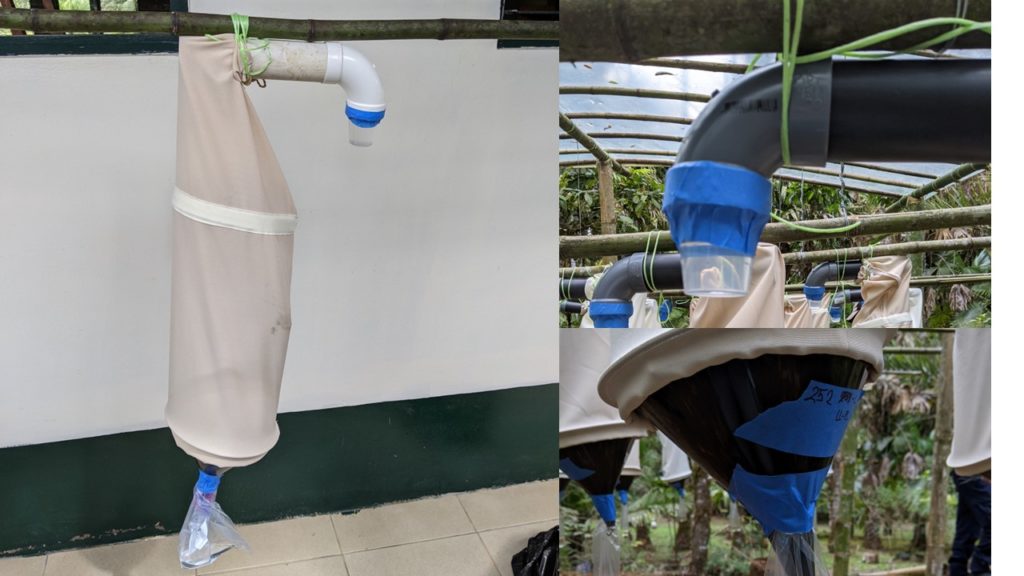As I prepared to head to Costa Rica on my second field season, year 1 after Covid hit, I was facing challenges that went beyond trying to get into a foreign country during a pandemic or finding ethanol to preserve samples. After convincing my university that I would be okay travelling, I had to confront one of the main disruptions that covid brought to field research: extreme slow downs in the supply chain and limited budgets.
Part of my project involved studying insects inside dead logs. I had intended to assess this by extracting insects from dead wood after leaving logs in the field for one year. While methodologies exist to extract insects from soil, it is less common and much more difficult to extract them from other “things”, such as plants or dead wood. Berlese funnels are a commonly used method to collect soil fauna, and consist of a funnel on top of which the heat of an incandescent light bulb “pushes” arthropods down the funnel where they fall into a collecting vial filled with ethanol.
With limited access to materials, I had to think about how I could adapt this strategy to collect arthropods from inside dead logs. Several requirements needed to be fulfilled. First, the design had to be simple and cost effective as I had a very limited budget. Second, the logs had to be in a sealed environment to prevent insects from escaping. Third, to have enough statistical power, I had to extract insects from a total of 180 dead logs, which would require a significant amount of space. Finally, I had to think about flying insects. How would I ensure that I captured these insects knowing that they tend to fly upwards as opposed to down the funnel?

My field assistants, Chulo, Diego, and Junior building the “shed” for our Berlese funnels at Las Cruces Biological Station.
Thanks to my design and sewing abilities (glad I have architects as parents!) and the exceptional construction skills of my field assistants, Jeisson and Alamo, we eventually came up with a solution. I intentionally make a pause here to stress that while this note will teach you how to adapt Berlese funnels for a variety of purposes, it is also a reminder to field biologists that creativity and the integration of local knowledge are critical for field experiments. Without Jeisson and Alamo, I would have ended up with a good design… but a barely functioning construction. Merging our skills was key to the success of our experiment.
We solved the space issue by deciding to build a covered shed which would hold 36 logs at a time (yes, covered because it pours rain every day in southern Costa Rica). To build our modified Berlese funnels, we used plastic funnels typically used for gasoline and attached a plastic baggie underneath to collect arthropods.

The first prototype of our modified Berlese funnel, which successfully held a log inside it. To the right, a detail of the upper and bottom sections of the device. I should trademark these, don't you think?
The upper part of the system was a bit more complex. Using my sewing skills, I designed a zippered cylindrical structure that would be anchored to the funnel and would allow me to introduce logs while being tightly closed once the logs were inside. I wanted to prevent the logs from touching the fabric because this could enable some insects to escape. So, we had to add an internal seam where metal wire was introduced to maintain the cylindrical shape of the fabric structure. Finally, to make sure that we captured flying arthropods, Jeisson helped me in creating a “tunnel” structure that would guide arthropods towards an upper trap. To build this tunnel, we connected an elbow pipe to a plastic vial trap on one side, and to a straight pipe that went into the funnel on the other side. Both funnels and logs were attached to the bamboo poles in our shed using rope (fairly rudimentarily), and were left untouched for ~4 days until no more insects came out. The result of our work is shown below. Who would know that you would develop design and construction skills as a field biologist!

The whole project, including the shed and the logs. My friend and visiting artist Esteban Hidalgo called the composition, “the living dead ” because even though the logs were dead, they contained such immense living biodiversity inside of them. Love the oxymoron!

A log hanging from a rope, soon to be introduced into its funnel. Note all the plants growing on it.
